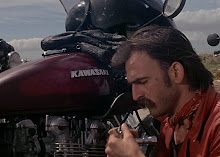NSU started as a knitting machine company that moved on to producing bicycles. Bicycle production was soon joined by car, truck and motorcycle production. Have you ever seen the Kettenkrad, the half-track motorcycle that could climb a 24° slope? That was built by NSU. The first road car to feature the Wankel rotary was also built by NSU.
In the early 50s, NSU set four world speed record. By 1955, NSU was the largest motorcycle manufacturer in the world. One year later, Wilhem Hertz and his NSU broke the 200 mph barrier on a motorcycle. The 1950s also saw NSU win numerous times at the Isle of Man. The optimistically-named NSU Quickly is the best-selling moped of all time, selling over one million units.
The glory was not to last for NSU, though. Along with DKW (oddly, the company NSU surpassed as the world's largest motorcycle manufacturer), they were purchased by Volkswagen in 1969. NSU and DKW were eventually morphed into Audi and dissolved. The final NSU-badged vehicle, the Ro 80, ceased production in 1977 amid reliability woes and an extremely poor resale value.
NSU made many interesting vehicles, such as the Max, the Kettenkrad and the TTS, over their history. A particular model that stands out to me is the 250 Rennmax. It was built to take on the all-conquering Italian bikes of the early 50s, especially the Moto Guzzis ridden by Enrico Lorenzetti and Fergus Anderson.
The Rennmax was a dedicated race bike that shared little, if anything at all, with its road-going NSU brethren. It used a pressed steel monocoque chassis, aluminum bodywork and a one-off parallel twin engine. The engine was a bevel-drive DOHC-type with two valves per cylinder and two carbs. Each cam was operated by its own bevel shaft. It put out 30 hp at 10,500 rpm and was backed up by a five-speed gearbox.
The bike debuted in 1952 and caused quite a stir, despite losing to the Guzzis in the world championship. NSU returned on a mission the following year and Werner Haas won the 125cc and the 250cc championship for NSU.
Eager to continue its winning ways, NSU completely overhauled the Rennmax for 1954. The twin bevel was ditched for a single shaft, which operated the twin cams via an idler gear between them. The bore and stroke were changed and a sixth gear was added to the gearbox. What this meant was more power, up to 36 hp at 11,000 rpm, and a top speed nearing 140 mph with the proper fairing. The 1954 Rennmax dominated the world championship, with Haas winning every race he entered. Haas went on the claim the 1954 title, his second on an NSU. NSU pulled out of racing after the 1954 season but the Rennmax continued to be competitive for a number of years following.
What makes the NSU Rennmax special to me was its competitiveness and its technology. Many of its contemporaries relied on production techniques for their racing bikes. The racing machines weren't much removed from the showroom machines. NSU approached things differently by designing a completely one-off engine that was pretty advanced and using a different frame type. Its competitors used a backbone-style steel frame, similar to most production bikes. The pressed steel monocoque of the Rennmax was a different idea all together. The monocoque frame would be tried decades later by Norton and OSSA, with varying degrees of success.
Another thing I like about the Rennmax was its dominance. It only raced for a few years and managed to win three championships in that short time. That's a hell of a record.
It's a shame that NSU is sort of forgotten. They achieved many great things in the automotive and motorcycle world and don't seem to get the credit they deserve. NSU is often relegated to trivia fodder when they should be recognized as one of the greats of all time.
This is the early NSU Rennmax with the twin bevel shafts.
This is a different version of the earlier Rennmax. This one has the full fairing, allowing a higher top speed.
For the 1954 overhaul, the Rennmax's engine switched from twin bevel shafts to one.




No comments:
Post a Comment